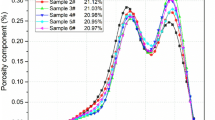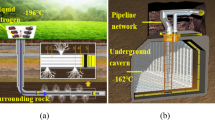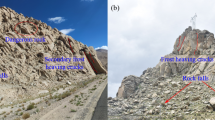Abstract
Volumetric expansion of water by 9% in saturated pores and cracks causes substantial frost deformation in rock masses. Frost deformation is an important index reflecting the frost resistance of rocks; however, water saturation has a great influence on the frost deformation characteristics. In this research, the frost strains and acoustic emission activities of red sandstone with different water saturations are monitored under freeze–thaw conditions. The experimental results show that both the peak and the residual frost heaving strains greatly increase for sandstone beyond 85% water saturation. However, there is no significant frost heaving strain that occurs in low-saturation red sandstone (less than 85% water saturation). The acoustic emission activities show the same change trend and further confirm the existence of this critical saturation. In addition, the pore size distribution also has a great influence on the frost heaving strain and freeze–thaw damage. All the liquid pore water in this red sandstone is frozen at − 20 °C because the pores are larger than the critical freezing radius (2.58 nm at − 20 °C) according to the measured pore size distribution. Based on the pore micromechanics and Gibbs–Thomson equation, a developed frost heaving model is proposed considering the effects of water saturation and the pore size distribution. The proposed model can be used to predict the frost heaving strain at any freezing temperature for unsaturated red sandstone. This study thus provides the frost deformation characteristics of red sandstone and contributes to a better understanding of the freeze–thaw damage mechanism of unsaturated sandstone.























Similar content being viewed by others
Abbreviations
- ρ r, ρ i, ρ l :
-
Densities of rock matrix, solid ice and water, respectively
- UCS:
-
Uniaxial compressive strength
- E r, E i :
-
Elastic moduli of red sandstone and solid ice, respectively
- μ r, μ i :
-
Poisson’s ratio of red sandstone and solid ice, respectively
- n :
-
Porosity of red sandstone
- v r :
-
P-wave velocity of rock
- α r :
-
Thermal expansion coefficient of rock
- \(\ell\) :
-
Latent heat per unit mass of water
- T m :
-
Freezing point of bulk water
- γ il :
-
Free energy of ice-liquid interfacial
- m r1, m r2 :
-
Masses of the red sandstone sample before and after sticking the strain gauges
- m d, m s1 :
-
Masses of the dry and saturated red sandstone sample, respectively
- m t :
-
Mass of the sandstone sample corresponding to the specific saturation
- S r :
-
Saturation of rock
- \(\varepsilon_{{\text{n}}}^{{\text{d}}}\), \(\varepsilon_{{\text{r}}}^{{\text{d}}}\) :
-
Total nominal strain and the actual strain of dry red sandstone, respectively
- \(\varepsilon_{{\text{e}}}\) :
-
Strain error
- T, T 0 :
-
Current temperature and initial temperature, respectively
- \(\alpha_{{\text{n}}}^{{\text{d}}}\) :
-
Nominal thermal expansion coefficient of red sandstone
- \(\alpha_{{\text{r}}}^{{\text{d}}}\) :
-
Actual thermal expansion coefficient of red sandstone
- \({\alpha }_{\mathrm{e}}\) :
-
Thermal expansion coefficient of the glue and strain gauge
- \(\varepsilon_{{\text{p}}}^{{{\text{sa}}}}\) :
-
Peak frost heaving strain of saturated sandstone
- \(\varepsilon_{{{\text{re}}}}^{{{\text{sa}}}}\) :
-
Residual strain of saturated sandstone
- \({a}_{1}\), \({b}_{1}{,a}_{2}\), \({b}_{2}\) :
-
Unknown frost heaving parameters
- \(K_{{\text{r}}}\) :
-
Bulk modulus of rock
- \(\varepsilon_{{\text{T}}}\) :
-
Linear thermal strain
- \(\varepsilon_{{\text{f}}}\) :
-
Linear frost heaving strain caused by ice pressure
- \(b\) :
-
Biot coefficient
- \(p_{{\text{i}}}^{{\text{s}}}\) :
-
Equivalent pore ice pressure
- \(w_{{\text{u}}} (T)\) :
-
Unfrozen water content
- \(F(r)\) :
-
Cumulative distribution function of the pore size
- \(r\) :
-
Radius of the sphere pore
- m 1, m 2 :
-
Characteristic size of coarse pores and thin pores, respectively
- V 1, V 2 :
-
Volume fractions of the coarse and thin pores, respectively.
- \(\xi (S_{{\text{r}}} )\) :
-
Impact coefficient of water saturation
References
Al-Omari A, Beck K, Brunetaud X, Török Á, Al-Mukhtar M (2015) Critical degree of saturation: a control factor of freeze–thaw damage of porous limestones at Castle of Chambord, France. Eng Geol 185:71–80
Amitrano D, Gruber S, Girard L (2012) Evidence of frost-cracking inferred from acoustic emissions in a high-alpine rock-wall. Earth Planet Sci Lett 341:86–93
Binal A (2009) A new laboratory rock test based on freeze–thaw using a steel chamber. Q J Eng Geol Hydrogeol 42(2):179–198
Chen TC, Yeung MR, Mori N (2004) Effect of water saturation on deterioration of welded tuff due to freeze–thaw action. Cold Reg Sci Technol 38(2–3):127–136
Coussy O, Monteiro P (2007) Unsaturated poroelasticity for crystallization in pores. Comput Geotech 34(4):279–290
Dormieux L, Kondo D, Ulm FJ (2006) Microporomechanics. Wiley
Eslami J, Walbert C, Beaucour AL, Bourges A, Noumowe A (2018) Influence of physical and mechanical properties on the durability of limestone subjected to freeze–thaw cycles. Constr Build Mater 62:420–429
Fang T, Huang M (2019) Deformation and load-bearing characteristics of step-tapered piles in clay under lateral load. Int J Geomech 19(6):04019053
Fang W, Jiang N, Luo X (2019) Establishment of damage statistical constitutive model of loaded rock and method for determining its parameters under freeze–thaw condition. Cold Reg Sci Technol 160:31–38
Freire-Lista DM, Fort R, Varas-Muriel MJ (2015) Freeze–thaw fracturing in building granites. Cold Reg Sci Technol 113:40–51
Fu HL, Zhang JB, Huang Z, Shi Y, Chen W (2018) A statistical model for predicting the triaxial compressive strength of transversely isotropic rocks subjected to freeze–thaw cycling. Cold Reg Sci Technol 145:237–248
Girard L, Gruber S, Weber S, Beutel J (2013) Environmental controls of frost cracking revealed through in situ acoustic emission measurements in steep bedrock. Geophys Res Lett 40(9):1748–1753
Hori M, Morihiro H (1998) Micromechanical analysis on deterioration due to freezing and thawing in porous brittle materials. Int J Eng Sci 36(4):511–522
Hu Z, Ding H, Lai J, Wang H, Wang X, He S (2018) The durability of shotcrete in cold region tunnel: a review. Constr Build Mater 185:670–683
Huang SB, Liu QS, Cheng AP, Liu YZ (2018a) A statistical damage constitutive model under freeze–thaw and loading for rock and its engineering application. Cold Reg Sci Technol 145:142–150
Huang SB, Liu QS, Liu YZ, Kang YS, Cheng AP, Ye ZY (2018b) Frost heaving and frost cracking of elliptical cavities (fractures) in low-permeability rock. Eng Geol 234:1–10
Huang SB, Liu QS, Liu YZ, Ye ZY, Cheng AP (2018c) Freezing strain model for estimating the unfrozen water content of saturated rock under low temperature. Int J Geomech 18(2):04017137
Huang SB, Liu QS, Liu YZ, Ye ZY, Cheng AP (2019a) Closure to “freezing strain model for estimating the unfrozen water content of saturated rock under low temperature” by Shibing Huang, Quansheng Liu, Yanzhang Liu, Zuyang Ye, and Aiping Cheng. Int J Geomech 19(7):07019002
Huang SB, Liu YZ, Guo YL, Zhang ZL, Cai YT (2019b) Strength and failure characteristics of rock-like material containing single crack under freeze–thaw and uniaxial compression. Cold Reg Sci Technol 162:1–10
Huang SB, Zexin Lu, Ye ZY, Xin ZK (2020a) An elastoplastic model of frost deformation for the porous rock under freeze–thaw. Eng Geol 278:105820. https://doi.org/10.1016/j.enggeo.2020.105820
Huang SB, Ye YH, Cui XZ, Cheng AP, Liu GF (2020b) Theoretical and experimental study of the frost heaving characteristics of the saturated sandstone under low temperature. Cold Reg Sci Technol 174:103016. https://doi.org/10.1016/j.coldregions.2020.103036
Huang SB, He YB, Liu GF, Lu ZX, Xin ZK (2021) Effect of water content on the mechanical properties and deformation characteristics of the clay-bearing red sandstone. B Eng Geol Environ. https://doi.org/10.1007/s10064-020-01994-6
Jia HL, Xiang W, Krautblatter M (2015) Quantifying rock fatigue and decreasing compressive and tensile strength after repeated freeze-thaw cycles. Permafrost Periglac 26(4):368–377
Jia HL, Zi F, Yang GS, Li GY, Shen YJ, Sun Q, Yang PY (2020a) Influence of pore water (ice) content on the strength and deformability of frozen argillaceous siltstone. Rock Mech Rock Eng 53(2):967–974. https://doi.org/10.1007/s00603-019-01943-0
Jia HL, Ding S, Fan Z, Dong YH, Shen YJ (2020b) Evolution in sandstone pore structures with freeze–thaw cycling and interpretation of damage mechanisms in saturated porous rocks. CATENA 195:104915. https://doi.org/10.1016/j.catena.2020.104915
Kong B, Wang E, Li Z, Wang X, Liu J, Li N (2016) Fracture mechanical behavior of sandstone subjected to high-temperature treatment and its acoustic emission characteristics under uniaxial compression conditions. Rock Mech Rock Eng 49(12):4911–4918
Lai J, Qiu J, Fan H, Chen J, Xie Y (2016) Freeze-proof method and test verification of a cold region tunnel employing electric heat tracing. Tunn Undergr Sp Technol 60:56–65
Lide DR (ed) (2004) CRC handbook of chemistry and physics, vol 85. CRC Press
Liu QS, Huang SB, Kang YS, Liu XW (2015) A prediction model for uniaxial compressive strength of deteriorated rocks due to freeze–thaw. Cold Reg Sci Technol 120:96–107
Liu B, Ma Y, Liu N, Han Y, Li D, Deng H (2019) Investigation of pore structure changes in Mesozoic water-rich sandstone induced by freeze–thaw process under different confining pressures using digital rock technology. Cold Reg Sci Technol 161:137–149
Liu YZ, Cai YT, Huang SB, Guo YL, Liu GF (2020) Effect of water saturation on uniaxial compressive strength and damage degree of clay-bearing sandstone under freeze–thaw. B Eng Geol Environ 79:2021–2036
Lu Y, Li X, Chan A (2019) Damage constitutive model of single flaw sandstone under freeze–thaw and load. Cold Reg Sci Technol 159:20–28
Luo XD, Jiang N, Zuo CQ, Dai ZW, Yan ST (2014) Damage characteristics of altered and unaltered diabases subjected to extremely cold freeze–thaw cycles. Rock Mech Rock Eng 47(6):1997–2004
Lv ZT, Xia CC, Li Q, Si ZP (2019) Empirical frost heave model for saturated rock under uniform and unidirectional freezing conditions. Rock Mech Rock Eng 52(3):955–963
Matsuoka N (1990) Mechanisms of rock breakdown by frost action: an experimental approach. Cold Reg Sci Technol 17(3):253–270
Mellor M (1970) Phase composition of pore water in cold rocks. Cold Regions Research and Engineering Laboratory, Hanover
Meng Q, Zhang M, Han L, Pu H, Chen Y (2018) Acoustic emission characteristics of red sandstone specimens under uniaxial cyclic loading and unloading compression. Rock Mech Rock Eng 51(4):969–988
Momeni A, Abdilor Y, Khanlari GR et al (2016) The effect of freeze–thaw cycles on physical and mechanical properties of granitoid hard rocks. B Eng Geol Environ 75(4):1649–1656
Park J, Hyun CU, Park HD (2015) Changes in microstructure and physical properties of rocks caused by artificial freeze–thaw action. B Eng Geol Environ 74(2):555–565
Prick A (1997) Critical degree of saturation as a threshold moisture level in frost weathering of limestones. Permafrost Periglac 8(1):91–99
Sarici DE, Ozdemir E (2018) Determining point load strength loss from porosity, Schmidt hardness, and weight of some sedimentary rocks under freeze–thaw conditions. Environ Earth Sci 77(3):62
Tan XJ, Chen WZ, Yang DS, Dai YH, Wu GJ, Yang JP, Yu HD, Tian HM, Zhao WS (2014) Study on the influence of airflow on the temperature of the surrounding rock in a cold region tunnel and its application to insulation layer design. Appl Therm Eng 67(1–2):320–334
Tan XJ, Chen WZ, Liu HY, Wang LY, Ma W, Chan AHC (2018) A unified model for frost heave pressure in the rock with a penny-shaped fracture during freezing. Cold Reg Sci Technol 153:1–9
Wang P, Xu J, Liu S, Wang H, Liu S (2016) Static and dynamic mechanical properties of sedimentary rock after freeze–thaw or thermal shock weathering. Eng Geol 210:148–157
Wang LP, Li N, Qi JL, Tian YZ, Xu SH (2019) A study on the physical index change and triaxial compression test of intact hard rock subjected to freeze–thaw cycles. Cold Reg Sci Technol 160:39–47
Wang WJ, Yang XL, Huang SB, Yin D, Liu GF (2020) Experimental study on the shear behavior of the bonding interface between sandstone and cement mortar under freeze–thaw. Rock Mech Rock Eng 53:881–907
Watanabe K, Mizoguchi M (2002) Amount of unfrozen water in frozen porous media saturated with solution. Cold Reg Sci Technol 34(2):103–110
Wu T, Liaw HC, Chen YZ (2002) Thermal effect of surface tension on the inward solidification of spheres. Int J Heat Mass Tran 45(10):2055–2065
Xia CC, Lv ZT, Li Q, Huang JH, Bai XY (2018) Transversely isotropic frost heave of saturated rock under unidirectional freezing condition and induced frost heaving force in cold region tunnels. Cold Reg Sci Technol 152:48–58
Yamabe T, Neaupane KM (2001) Determination of some thermo-mechanical properties of Sirahama sandstone under subzero temperature condition. Int J Rock Mech Min 38(7):1029–1034
Zhang HM, Meng XZ, Yang GS (2020) A study on mechanical properties and damage model of rock subjected to freeze–thaw cycles and confining pressure. Cold Reg Sci Technol 174:103056. https://doi.org/10.1016/j.coldregions.2020.103056
Zhang H, Yuan C, Yang G, Wu L, Peng C, Ye W, Moayedi H (2021) A novel constitutive modelling approach measured under simulated freeze–thaw cycles for the rock failure. Eng Comput 37:779–792. https://doi.org/10.1007/s00366-019-00856-4
Zhao X, Lv X, Wang L, Zhu Y, Dong H, Chen W, Ding Y (2015) Research of concrete residual strains monitoring based on WLI and FBG following exposure to freeze–thaw tests. Cold Reg Sci Technol 116:40–48
Zhou Z, Zhan H, Hu J, Ren C (2019) Characteristics of unloading creep of tuffaceous sandstone in east tianshan tunnel under freeze–thaw cycles. Adv Mater Sci Eng 20:7547564
Acknowledgements
This work was supported by National Natural Science Foundation of China (Grant nos. 42072300 and 41702291), Natural Science Foundation of Shaanxi Province (Grant no. 2019JQ171).
Author information
Authors and Affiliations
Corresponding authors
Ethics declarations
Conflict of interest
The authors declared that they have no conflicts of interest to this work.
Additional information
Publisher's Note
Springer Nature remains neutral with regard to jurisdictional claims in published maps and institutional affiliations.
Rights and permissions
About this article
Cite this article
Huang, S., Cai, Y., Liu, Y. et al. Experimental and Theoretical Study on Frost Deformation and Damage of Red Sandstones with Different Water Contents. Rock Mech Rock Eng 54, 4163–4181 (2021). https://doi.org/10.1007/s00603-021-02509-9
Received:
Accepted:
Published:
Issue Date:
DOI: https://doi.org/10.1007/s00603-021-02509-9




